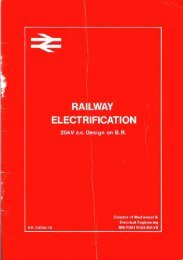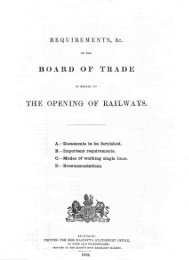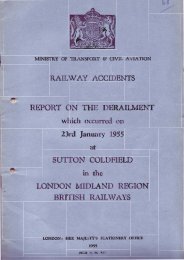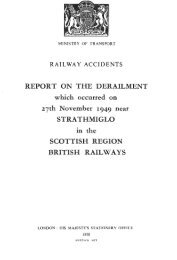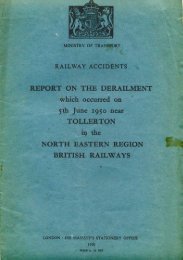R A I LT R AC K - The Railways Archive
R A I LT R AC K - The Railways Archive
R A I LT R AC K - The Railways Archive
You also want an ePaper? Increase the reach of your titles
YUMPU automatically turns print PDFs into web optimized ePapers that Google loves.
Route characteristics<br />
DESCRIPTION This route forms the principal rail connection between Dorset,<br />
Hampshire, West Surrey, and South West and central London.<br />
<strong>The</strong>re are eight tracks between Waterloo and Clapham Junction, where the<br />
lines diverge into a route to Reading (see Route 23: Clapham–Reading) and a<br />
four-track main line to Basingstoke.<br />
Beyond Basingstoke, the route is generally two track, although east of<br />
Dorchester there is a short section of single line. Maximum speeds are<br />
60–75mph in the London area and 90–100mph between Surbiton and Eastleigh.<br />
Speeds are more restricted beyond Eastleigh, although a maximum of 85mph is<br />
possible on some sections.<br />
<strong>The</strong> main line from Woking to Portsmouth Harbour is two track and<br />
maximum linespeeds vary due to severe curves and gradients. <strong>The</strong> route also<br />
contains a number of other feeder routes.<br />
Suburban routes branch off the main lines at Raynes Park for Chessington,<br />
Dorking and Epsom, at New Malden for Kingston and Shepperton, and at<br />
Surbiton for Hampton Court and Guildford via Effingham Junction. <strong>The</strong> suburban<br />
stations are capable of accepting eight-vehicle trains and this, together with the<br />
limiting capacity of the main line at Waterloo, limits the short-term options to<br />
reduce overcrowding on trains at peak times.<br />
A p a rt from Basingstoke–Reading, the route is third-rail electri fied throughout.<br />
Route vision<br />
Our vision is to improve further the route to maintain and grow the market<br />
share, providing a smooth and fast route for passengers to the coast and a<br />
frequent, punctual and comfortable suburban network for South West London.<br />
This will be achieved by working with our customers to enable the introduction<br />
of new rolling stock, concentrating resources on track quality and linespeeds and<br />
on using the last ten miles into London in the most cost-effective manner to<br />
manage the continuing demands for peak capacity.<br />
On this route, there has been a substantial increase in passengers travelling<br />
at peak times in and out of Waterloo Station which has created severe<br />
overcrowding on many of South West Trains’ main line and suburban trains. Our<br />
forecasts show that this growth will continue .<br />
With the approaches to Waterloo operating close to capacity throughout<br />
the day, opportunities for immediate improvements are limited. A joint study of<br />
Route development and customer requirements<br />
Train performance is an area that we and our customers take very seriously. We<br />
are developing a strategy that will see a rapid and steady reduction in<br />
infrastructure failures on the critical section between Raynes Park and Waterloo.<br />
We anticipate that this improvement will be tangible by the next NMS, and this<br />
will be achieved through enhanced maintenance and targeted renewals of<br />
infrastructure. Together with our contractors, we have developed teams of<br />
specialists who target persistent infrastructure failures until they are eliminated.<br />
We see this as an essential part of our endeavouring to drive down train delays<br />
and improve train punctuality. We are also working with our customers on<br />
initiatives that will yield performance improvements through train timetabling and<br />
contingency planning.<br />
Working with train operators, we will improve charter punctuality by two<br />
percentage points over the next two years. This improvement, which will vary<br />
across service groups, will typically result in 16% fewer trains arriving at their<br />
destinations more than five minutes late.<br />
We are continually looking at ways in which journey times can be improved<br />
by taking opportunities afforded by track renewals, resignalling schemes and<br />
major maintenance.<br />
<strong>The</strong> resignalling of the Bournemouth area will provide opportunities for<br />
minor enhancements to the operational flexibility and capacity of the route.<br />
Our analysis of future freight train volumes shows that projected<br />
movements can be accommodated up to 2004. <strong>The</strong> position beyond 2004 and<br />
the proposed growth of Southampton’s deep-water port facilities at Dibden Bay<br />
requires further evaluation. This will be complete by May this year and will<br />
include an assessment of provision of larger-gauge freight trains to W10 gauge.<br />
During our regular discussions with local authorities and user groups, many<br />
suggestions are made that have the potential to improve our network. Two such<br />
developments are improvements to the Alton Line where journey times and<br />
<strong>The</strong> route is primarily a passenger railway but with freight carried on many of the<br />
lines. Freight tonnage and traffic levels are particularly significant between<br />
Southampton and Reading.<br />
BOTTLENECK ANALYSIS <strong>The</strong> route between Southampton and<br />
Bournemouth was identified in the 1998 NMS as a potential bottleneck. Further<br />
analysis has shown that there is sufficient capacity for all the identified existing<br />
and future passenger demand. However, we may need to make some specific<br />
provision if the new Southampton–Dibden Bay container terminal traffic exceeds<br />
current expectations.<br />
MAJOR STAT I O N S<br />
London Waterloo Waterloo’s important role as an interchange between<br />
domestic, international and underground routes will be enhanced with the<br />
completion of the Jubilee Line Extension. SRP work has been reprogrammed to<br />
enable improvements to station facilities to be incorporated and will begin in<br />
1999/2000. We will work with South West Trains to develop proposals for<br />
automatic ticket gates and new customer-information systems to be<br />
implemented by 2000/01.<br />
suburban capacity is under way with South West Trains to develop potential<br />
solutions. Any immediate solutions will be announced before the next NMS. We<br />
anticipate that short- and medium-term possibilities will include higher-density<br />
rolling stock which could include double-decker trains and longer trains coupled<br />
with a platform lengthening programme. <strong>The</strong> longer-term solutions will include<br />
major infrastructure enhancements on the main line to Waterloo. Where<br />
solutions are uneconomical, we will be offering options to potential funders to<br />
assist us. In anticipation that short-term, commercially viable improvements will<br />
arise from the study, we have set aside £5M to spend by 2003 to reduce<br />
congestion and overcrowding. <strong>The</strong> results of the study will be available for the<br />
next NMS.<br />
capacity improvements are sought, and the reopening of the freight-only spur<br />
between Eastleigh and Chandler’s Ford (on Route 22) to passenger operation.<br />
We will be looking at the economics of these proposals and will be discussing<br />
them with funding bodies when the studies are complete.<br />
With the Purbeck Rail Partnership, we are examining the feasibility of<br />
restoring the rail link between the Swanage Railway and the national rail network.<br />
This would enable a direct train service to operate between Swanage, Wareham,<br />
Poole and Bournemouth.<br />
Work is going forward with Basingstoke and Deane BC and Thames Trains<br />
on a proposal for a new station at Chineham on the Basingstoke–Reading Line.<br />
A potential further new station at Grazeley, between Mortimer and Reading<br />
West, is planned in association with a major residential development. This is<br />
currently subject to a planning enquiry.<br />
Work at Wimbledon Depot is being carried out to accommodate South<br />
West Trains’ new Class 458 rolling stock. Work at Fratton Depot is complete,<br />
and work at Bournemouth Depot will be completed in July 1999.<br />
Planning permission has been sought for a major development at Woking<br />
Station. If successful, the opportunity will be taken to improve station facilities at<br />
the same time.<br />
We intend to work with customers to improve the attractiveness of<br />
stations through completion of the regeneration programme and we will be<br />
renewing customer-information systems on South West Trains’ operating area<br />
over the next two years. In addition, major works will begin at Southampton<br />
Central Station during 2000.<br />
A review of car-park capacity is under way and, together with our<br />
customers, we have identified some that could be extended. Currently,<br />
extension works are to be undertaken at Winchester and Basingstoke.<br />
243



